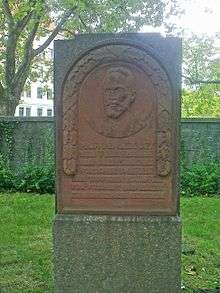Caspar René Gregory
| Caspar René Gregory | |
|---|---|
 | |
| Born |
November 6, 1846 Philadelphia |
| Died |
April 9, 1917 (aged 70) near Neufchâtel-sur-Aisne |
| Nationality | American-German |
| Fields | Theology |
| Institutions | University of Leipzig |
| Known for | Textkritik des neuen Testamentes |
Caspar René Gregory (November 6, 1846 – April 9, 1917) was an American-born German theologian.
Life
Gregory was born in Philadelphia.[1] After completing his bachelor's degree at the University of Pennsylvania in 1864, he studied theology at two Presbyterian seminaries: in 1865–1867 at the Reformed Presbyterian Theological Seminary, Philadelphia, and in 1867–1873 at the Princeton Theological Seminary.[2] In 1873, he decided to continue his studies at the University of Leipzig under Constantin von Tischendorf, to whose work on textual criticism of the New Testament he had been referred by his teacher Ezra Abbot. He administered the scientific legacy of Tischendorf, who died in 1874, and continued his work.
In 1876, he obtained his PhD. with a dissertation on Grégoire the priest and the revolutionist. The first examiner for it was the historian Georg Voigt.[3]
He completed his post-doctoral work in Leipzig in 1884, and became an associate professor in 1889 and a full honorary professor in 1891. He apparently had several doctorates: Karl Josef Friedrich (p. 130) even mentions five doctorates in his biography of Gregory. At least one doctorate in theology obtained in Leipzig in 1889 is attested. In June 1901, he received an honorary doctorate of Divinity from the University of Glasgow.[4]
In August 1914, Gregory, who had been a citizen of Saxony since 1881, enlisted in the German Army as its oldest wartime volunteer. He became a second lieutenant in 1916 and fell in 1917 on the western front. He died on April 9, 1917 in a field hospital in Neufchâtel-sur-Aisne, France.
Gregory specialized in New Testament textual criticism. He organized biblical manuscripts into a classification system (Die griechischen Handschriften des Neuen Testaments, 1908) which is the system in use throughout the scholarly world today. He is also credited with being the first to notice the consistent medieval practice (called Gregory's Law or Gregory's Rule) of collating parchment leaves so that grain side faced grain side and flesh side flesh side.[5] He was also interested in biblical canon.
Gregory performed important service in the research of New Testament manuscripts and in textual criticism of the New Testament. It can even be said that the study of New Testament manuscripts was co-founded by Tischendorf and Gregory.

Besides his work, he is remembered by a memorial stone with a portrait in relief in Leipzig on Naunhofer Straße in front of the new Nickolai School in the Stötteritz part of the city, as well as a small square nearby.
Works
- Prolegomena zu Tischendorfs Novum Testamentum Graece (editio VIII. critica major), 2 Vols., 1884-94 (German revised edition: text criticism of the NT, 3 Vols., 1900–09).
- Gregory, C. R. (1900). Textkritik des Neuen Testaments (in German). 1. Leipzig: J.C. Hinrichs’sche Buchhandlung. Retrieved 2010-03-18.
- Gregory, C. R. (1907). Canon and Text of the New Testament. New York: Charles Scribner's Sons. Retrieved 2011-08-03.
- Das Freer-Logion (Hinrichs: Leipzig 1908)
- Die griechischen Handschriften des Neuen Testaments, Leipzig 1908.
- Einleitung in das Neue Testament, 1909
- Vorschläge für eine kritische Ausgabe des griechischen Neuen Testaments, 1911.
- Die Koridethi-Evangelien, 1913.
- Zu Fuß in Bibellanden, publ. by Hermann Guthe, 1919.
- journal articles
- "The Essay 'Contra Novatianum'". The American Journal of Theology 3 (1899): 566–570.
References
- ↑ Barnikol, Ernst (1966). "Gregory, Caspar René". In: Neue Deutsche Biographie 7 (1966), p. 27-29. Online version.
- ↑ "Caspar René Gregory" (1911). The Biblical World. Vol. 38, no. 5, p. 350-354; here, p. 351.
- ↑ Todte, Mario (2004). Georg Voigt (1827-1891). Pionier der historischen Humanismusforschung. Leipzig: Leipziger Universitätsverlag. p. 111. ISBN 3937209220.
- ↑ "Glasgow University jubilee". The Times (36481). London. 14 June 1901. p. 10.
- ↑ Avrin, Leila (1991). Scribes, Script, and Books: The Book Arts from Antiquity to the Renaissance. Chicago; London: American Library Association; The British Library. p. 213. ISBN 978-0-8389-0522-7.
Literature
- Ernst Barnikol (1966), "Gregory, Caspar René", Neue Deutsche Biographie (NDB) (in German), 7, Berlin: Duncker & Humblot, pp. 27–29; (full text online).
- Friedrich Wilhelm Bautz (1990). "Caspar René Gregory". In Bautz, Friedrich Wilhelm. Biographisch-Bibliographisches Kirchenlexikon (BBKL) (in German). 2. Hamm: Bautz. col. 344. ISBN 3-88309-032-8.
- Karl Josef Friedrich, Caspar Rene Gregory, in: Sächsische Lebensbilder, Vol. I, Dresden 1930, p. 125-131. (German)
- Ernst Jünger, ed. (1928), "Caspar René Gregory", in: Die Unvergessenen. Berlin: Andermann. p. 111 ff. (German)
- Bruno Hartung (1929), "Caspar René Gregory", in: Das Jahr des Herrn: Kalender für die evangelischen Gemeinden Leipzigs. 5. Jg., p. 36-38. (German)
External links
- From the Papers of Caspar René Gregory. In "Of the Incomparable Treasure of the Holy Scriptures: An Exhibit of Historic Bible-related Materials from the Collection of the Andover-Harvard Theological Library," October 1998
- Caspar René Gregory in the German National Library catalogue
- Biographical sketch in The Biblical World, Vol. 38 (1911), pp. 350-354
- Gregory's obituary in the New York Times